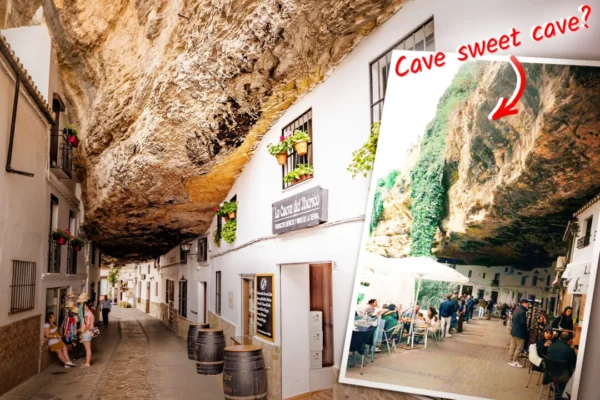A beautiful street winds along a basin in the shadow, with wine cellars and restaurants on either side. This shady street flows under a bumpy giant rock, mysteriously hanging as if magically softened, tightly squeezed between whitewashed walls enjoyed by locals and travelers alike in the cool August shadow.
This strange giant rock towering above appears even bigger than what meets the eye. A massive cliff hangs down, seemingly crushing the buildings, making it hard to distinguish if the shops are built among the rocks or the rocks form around the shops? These questions invite exploration for answers. However, watching the bustling, shady street, one wouldn’t wonder why Moorish settlers in the 12th century chose to settle in this marvelous enclave centuries ago.
The scorching Andalusian sun casting this vast shadow might explain it all. The first cave dwellers arriving here, now the town of Setenil de las Bodegas in the southern mountains of Spain with a population of 3,000, might have noticed that the natural rock curves in the valley not only provided prefabricated walls and ceilings but also offered shade and a steady temperature: the rock’s thermal inertia keeping it warm in winter and cool in summer. They came here to seek refuge from the sun. Finding a cool corner, they made it their home.
Today, this street is a hotspot for tourism and a dream for various bloggers, although the narrow streets of the town require creativity from driving tourists, especially when it comes to finding parking spaces. This small town is a rare gem worth overnight stays. Visitors from all over come to see the whitewashed caves of this Andalusian town, one of the few painted towns nestled in the surrounding hills and also one of the most famous.
This bustling shady street is called Calle Cuevas del Sol, meaning Street of the Sun Caves, with an intriguing history that matches its strong tourist appeal. The name of this small town, Setenil de las Bodegas, hints at a purpose this shadowy street might have served. The name, one of several translations, is said to mean “seven fruitless attempts,” signifying the number of times invaders tried to conquer the town but failed.
The town held a strategic position, occupied in the 12th century by the Moors of the Almohad Caliphate. In 1407, Catholic invaders from the north launched the first siege on the town, unsuccessful. Subsequent six assaults followed until finally, the Moors were expelled in 1484, with the invaders using gunpowder and cannons against the Moors. The street known as the “Caves of the Sun” was used to keep agricultural produce cool in the hot Andalusian climate. It likely aided in defending the town.
Setenil is one of the last Muslim strongholds on the Iberian Peninsula, where visitors can still explore the remnants of Moorish defenses in Setenil. The ruins of the Nazari Castle still stand on the cliff, echoing the bygone era. During the Reconquista when Catholics opposed Moorish expansion, it boasted 40 towers, but today, visitors might find themselves standing on a crumbling stone.
Agriculture has long been a tradition in Andalusia. Upon recapturing the region, Catholics introduced grape cultivation for winemaking, almond, and olive oil pressing. Another translation of the town’s name, Setenil de las Bodegas, indicates wine as part of the region’s agricultural products. However, the flourishing wineries or wine cellars were completely destroyed by a root aphid infestation in the 1860s. Nevertheless, olive trees have continued to grow until today.
Apart from cave dwellings, one of the town’s most notable features is the whitewashing common in southern Spanish towns. The Moors also left this legacy, using “cal,” a compound of mature lime, for whitewashing village walls. This material can reflect sunlight, helping keep the houses cool during Andalusia’s scorching summers.
Some say the plague is associated with this pale color scheme. When cholera and yellow fever swept through southern Spain between the 16th and 19th centuries, houses were painted with “cal.”
Today, this wonderful shady street is vibrant. Locals and foreigners alike enjoy socializing here, frequenting the wine cellars and restaurants lining Calle Cuevas del Sol without worrying about rain or intense sun. It’s a local tradition to bring chairs out onto the street, chatting happily with neighbors, friends, or strangers under the cool shade of the trees.

